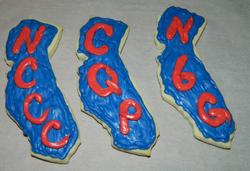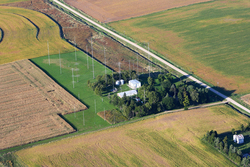 December 2, 2015 Editor: Paul Bourque, N1SFE | ||||
IN THIS ISSUE
NEW HF OPERATORS - THINGS TO DO This upcoming period is one of contrasts, with the ARRL 160 meter contest one week, followed by the ARRL 10 meter contest the next. It's an opportunity to appreciate the diversity and range of HF bands available to us. Top Band (160 meters) is the lowest frequency currently available for contest use. Operation in the contest will take place in twilight or the dark, using CW. On this challenging band, it's all about your antenna and separating noise from desired signals. In a suburb with 100 watts into a compromise antenna of a shortened dipole or a vertical with just a few radials, you can expect to work a number of states if you put a number of hours into your effort. In years with low sunspot numbers, 160 can come alive with signals from other continents, and from low noise locations you can work the world with wire antennas with good ground systems. Top Band operation can be addicting for its combination of challenges, rewards, and variability. Ten meters can be a 'counterpoise' to 160... Operation will occur mostly in daylight. The band is more likely to be open frequently on high-sunspot years, where gain antennas can be built with small amounts of materials. If 10 meters is open, signals from around the world can be very, very loud, and contest contacts are fast and exciting. When ten meters isn't open, you could be CQing into noise for a long time. You can check the ARRL Propagation pages for the forecast for your part of the US, and as a gateway for further propagation information. The ARRL 10 Meter Contest allows either or both CW or Phone contacts, which can be wonderful for avoiding fatigue in just one mode - check the rules to figure out which category you'd like to enter. Effective use of one good 10 meter opening during an otherwise closed-band weekend and you could be among the regional score leaders. You can 'warm up' to the ARRL 10 Meter contest with the NRAU contest on December 3, or the 10 Meter RTTY Contest on December 6. "Beginning with the 160 Meter contest, contesters entering ARRL HF contests will have the ability to submit their Cabrillo-formatted logs via an online website (URL is contest-log-submission.arrl.org) developed by Bruce Horn, WA7BNM (Submitting logs via email will still be available as always). Users of Bruce's website for uploading NAQP logs will recognize the familiar format. Once you have selected a few options to define your entry category and browsed to the log file, the web page will automatically determine what contest the log is for, then check all of the data and QSO lines. Note that the web page determines the contest from your log - you don't have to select the contest yourself. If there are any problems with the log data or discrepancies between the header and QSO line information, you'll see the highlighted errors so you can fix the problems and resubmit the log. If the log is accepted, you'll see the confirmation message and will receive a confirming email, just as with email log submission. The ARRL wishes to thank Bruce for his development efforts in support of contesting in general and also to the members of the Central Texas DX and Contest Club and the Society of Midwest Contesters who acted as beta testers with their Sweepstakes logs." (Ward, N0AX)
December is a month of activity for Europe's Youngsters on the Air! Besides on-the-air activities, the month will include a meeting of over 76 young hams from 22 countries in Toscana, Italy, for events focused around radio. You can track the activities on the group's YOTA Facebook Page, and be sure to be on the lookout for the 38 special-call stations participating in on-the-air activities. Last year, YOTA conference attendees also had the opportunity to take the US licensing exam, resulting in 16 US callsigns being issued. Complete information for all contests follows the Conversation section December 3 December 4 December 5
December 6 December 8 December 9 December 10 December 11 December 12
December 13 December 16 Maxwell's characterization of electromagnetic phenomena in equation form are 150 years old this week. Until Maxwell's work, magnetic and electric fields could be observed, but it was unclear how they were exactly related. Maxwell established how charge and current are linked; how we think about fields and antenna modeling builds upon his fundamental work. Controversy! High tech tools are being used to improve performance in competition, and not everyone in the sport of curling is happy about it. Some of the arguments sound familiar. If you notice an increase in band noise this time of year, it could be because some electronic holiday lights in your area are vomiting RFI. Greg, VE3FAX, reported that his neighbors Laser Christmas Lights (sold by a big-box home improvement retailer) were radiating across a wide swath of spectrum. (via the RFI Reflector) Oh those crazy Physicists! Periodically, for 80 years, a joke has been in front of all of us ; but as jokes go this one is very mild. Web Site of the Week - http://www.architectureofradio.com/ An intriguing concept: Combine information about radio wave sources and present it using 3D visualization - you get something like "Google Streets" for radio waves. Based on databases of emitters like cellular towers, satellites, and so on, this application for your iOS device (Android coming soon) lets you "visualize" field lines and transmitters in 3D as you rotate your device or move in space. Remember -- it's not a real-time display, but based on databases of transmitter locations. There's a video on the web site to give you the gist if you don't want to download the paid app, which is in early release. In technical usage, introducing a small amount of variation into a signal to achieve a particular effect. Clocks for electronic devices are sometimes 'dithered' to decrease the amplitude away from any one frequency (to meet specifications for government emissions approval for example) - by producing a wider spectrum of signals. While it may reduce the amount of emission on any one frequency, it can increase the noise across a wider spectrum. The clock-shifting concept originated with Hedy Lamarr and co-inventors , and was part of the original work on spread spectrum communications. In digital audio applications, combining a signal with a small amount of dithered noise can reduce decimation distortion at the expense of a small amount of noise. With modern radios, spotting networks, and contest logging programs, 'dithering' the frequency of contest spots can reduce the negative effect of hundreds or thousands of stations calling on nearly the exact same frequency to work a needed multiplier. Some contest logging programs can or will do this automatically on the basis of a setting.
Ken, K4ZW notes: 'World Wide Radio Operators Foundation (WWROF) sponsored Webinars, "Team W4AAW Totally Remote Multi-Multi Contesting" with K4XD, and K9LA's "Design Issues for a VHF-UHF Solid State RF Power Amplifier" have been posted to the WWROF webpage. Thanks to both Rowland K4XD and Carl K9LA for two excellent and informative presentations.' Many amateurs are interested in weather, and lightning in particular. Here's a spectacular video of lighting striking a car in Australia, taken with an HD dash camera. The Weather Channel's Facebook page also has a link to this video. What is very curious is that the vehicle is struck even though it's surrounded by much taller electrical lines.
The "rumors" of scores for last weekend's CQWW CW are pouring into 3830scores.com - and it's likely that there will be a new world record for the SOAB HP (Unassisted) category. Dan, N6MJ reports a score of 17.6 million points operating as ZF2MJ (from the ZF1A station). Over 48 hours, with two radios, he accumulated over ten thousand contacts, with hourly rates as low as 80, and as high as 359. Dan proclaims that his effort was only possible with the help and cooperation of a team of people to make sure antennas, radios, and associated gear was setup and ready. Even more impressive, this was Dan's first attempt at "being the DX." (Dennis N6KI) Results of the SAC contest are available. Next year's Scandinavian Activity Contest dates are September 17-18, 2016 (CW), and October 8-9, 2015 (SSB). OPERATING TIP If you're having trouble breaking through the pile-up for that multiplier you need, in CW, try varying your sending speed. If that doesn't work, try matching the speed of the other operator. Don't forget to also try sending a little bit off his frequency, especially if you 'found' the multiplier using a packet spot by clicking on it in your logging program. Chances are other contesters did the same, and their calling frequency could be exactly the same as yours. Some newer versions of popular contest logging programs vary the transmit frequency of spots to spread the pile-up, but you can manually separate your signal from the pack by a few Hertz. If you're sending 'stylish' CW using a bug, or non-standard dit/dah ratios with a modern keyer, that stands out, but don't go too far - if you're too different, you're just making it harder. Bonus Tip for the ARRL 160: If you have the antennas, remember to listen for signals from the southern hemisphere. Though it's summer there, ops will still be looking for contacts. Make sure you understand the summer hours of darkness in the areas you need... (Thanks for the reminder Dennis, W1UE) When we "let the smoke out" of equipment, it's usually not on purpose, but the US Military is has built a chip to do this on command . Heck, anyone who has ever seen a gassy 3-500z "run away" in a Heathkit SB-220 knows all about electronics and self-destruction. Troubleshooting SMDs in modern gear could be easier with these "smart tweezers" which don't require unsoldering of parts to make measurements. I think your SO needs one. Then you can borrow it when you need it. Dennis, N6KI, points out an interesting PortableSDR Kickstarter project combining GPS, Vector Network Analyzer, and QRP SDR Transceiver . Having already exceeded the kickstarter funding goal, the hardware may be ready in Q1/Q2 2016. Which under-$10 ARM-based computer do you need for your next project? Here's a comparison between the Raspberry Pi Zero and the Chip. It's great we have such power building blocks to use. Technical Web Site of the Week - sizes.com This week, sizes do matter. Modern or ancient, here are units of measure. Standard sizes for resistors. Concrete rebar. Aluminum alloy designators. Now that you have all the sizes you need, you'll have to figure out how to use them. Marathons & Sprints With the passing of another Well Known Contester, KL7RA, last week, we reflect on the fond memories we have of the loud and reliable contest signals Rich had from Alaska. Inevitably this prompts thoughts of our own mortality, and personal initiatives we can undertake to be able to stay contesting (and alive), longer. In many radio contests, to win requires a balance of high rates and the drive to work as many band multipliers as possible. As a contest operator, you're a part of the radio system during the contest period. It makes sense that you try to improve this part of the system as those improvements can lead to a better score. We often talk about contesting improvements in the form of increased or additional radio skills. Less often, we discuss the implicit general ability to prepare for contests by having the physical stamina to build and maintain our stations, to stay awake and alert during the contest periods, to be physically able to concentrate on the contesting tasks at hand, and to effectively manage the recovery from competition. There are all sorts of recommendations and research into appropriate nutrition, exercise, and personal care, and techniques to counter genetic inheritance, but underlying it all is the notion that a balance in all things may be a prudent course of action. I'm not necessarily advocating to "contest less." I am advocating a reflection on how you might be able to better balance your explicitly contest-related activities with those complementary non-contest activities which improve your overall well-being. To borrow a favorite tag-line from Hank, W6SX - Contest Exhuberantly! 73, Brian N9ADG 3 Dec - 16 Dec 2015 An expanded, downloadable version of QST's Contest Corral in PDF format is available. Check the sponsor's Web site for information on operating time restrictions and other instructions. HF CONTESTS CWops Mini-CWT Test , Dec 2, 1300z to Dec 2, 1400z, Dec 2, 1900z to Dec 2, 2000z, Dec 3, 0300z to Dec 3, 0400z; CW; Bands: 160, 80, 40, 20, 15, 10m; Member: Name + Member No., non-Member: Name + (state/province/country); Logs due: December 5. 3 Dec - 16 Dec 2015 December 3, 2015 December 4, 2015 December 5, 2015 December 6, 2015 December 8, 2015 December 10, 2015 December 12, 2015 December 15, 2015 ARRL Information Click here to advertise in this newsletter, space subject to availability. Your One-Stop Resource for Amateur Radio News and Information ARRL membership includes QST, Amateur Radio's most popular and informative journal, delivered to your mailbox each month. Subscribe to NCJ - the National Contest Journal. Published bimonthly, features articles by top contesters, letters, hints, statistics, scores, NA Sprint and QSO Parties. Subscribe to QEX - A Forum for Communications Experimenters. Published bimonthly, features technical articles, construction projects, columns and other items of interest to radio amateurs and communications professionals. Free of charge to ARRL members: Subscribe to The ARRL Letter (weekly digest of news and information), the ARES E-Letter (monthly public service and emergency communications news), Division and Section news -- and much more! ARRL offers a wide array of products to enhance your enjoyment of Amateur Radio. Visit the site often for new publications, specials and sales. Donate to the fund of your choice -- support programs not funded by member dues! Reprint permission can be obtained by sending email to permission@arrl.org with a description of the material and the reprint publication. ACKNOWLEDGEMENTS ARRL Contest Update wishes to acknowledge information from WA7BNM's Contest Calendar and SM3CER's Contest Calendar. The editor thanks KA7MOM for reviewing portions of this month's column. | ||||









